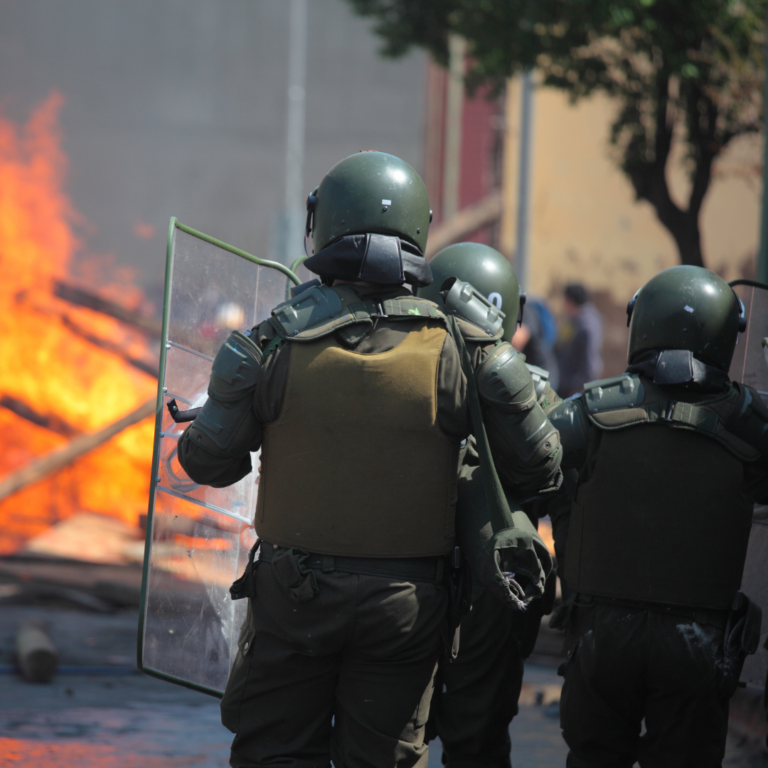NAVIGATING PROTEST SAFETY: A JOURNALIST’S GUIDE
In the world of journalism, covering protests can be both invigorating and challenging. While it provides an opportunity to report on important social and political issues, it also comes with potential risks. As a journalist, it’s essential to prioritise your safety while ensuring that you can effectively cover these events.
Having provided security and safety support for media crews & journalists in countless protests and demonstrations over the years, it’s clear that when working and advising journalists, it’s very important to recognise that covering protests comes with an ever-shifting level of risk.
Often, these protests are peaceful, however, others have the potential to turn violent and escalate into disorder very rapidly.
Here are some vital safety tips to keep in mind while covering protests.
Preparation and Research:
Before heading to a protest, conduct thorough research about the event, its organisers, and the potential participants. Understand the historical context, the established route, and any signs of previous violence or confrontation.
Dress Appropriately:
Dress in clothing that allows for easy movement, but also consider wearing protective gear such as helmets, gas masks, and goggles, especially if there is a risk of chemical irritants or projectiles being used.
Footwear and Clothing:
It may seem like a simple thing, however, ensure you are wearing good solid footwear to protect your feet. If you lose your shoes or suffer a lower limb injury your story will get away from you.
Dress for the environment, don’t wear anything which may affiliate you with protesting groups, keep a low profile, be the ‘Grey Person’.
Also, don’t wear anything which may get snagged or used against you should you end up in a confrontation such as hoods or loose belts, tuck away loose straps on your backpacks etc.
Lighten your load:
It’s highly likely you won’t stay static for long periods when covering protests, the action will move & your journalistic instinct will be to follow. The crucial thing here is to be mobile and light on your feet, simplify your kit and don’t take anything you don’t need. Rather than one person carrying all the kit, share the kit around within your team if possible. For example, consider if you need a tripod or can you shoot off the shoulder, or even better, can you carry a smaller camera?
Identification:
Always carry visible press identification such as press badges or vests to indicate your status as a journalist. It can help to distinguish you from the crowd and signal that you are there to report, not to participate.
Situational Awareness:
Maintain a high level of situational awareness at all times. Be mindful of your surroundings, look out for potential hazards, and pay attention to the behaviour of the crowd.
THINK SAFETY!
The biggest threat in a crowd is crushing and often the protestors weapon of choice or accessibility is a missile. Choosing a safe filming position will improve your safety & buy you valuable thinking time.
Think about using street furniture to protect you, having your back to a wall will stop anyone approaching from behind or filming from an elevated position.
If you find yourself in a confrontation or facing hostility, aim to extricate yourself quickly and safely, move together as a team where possible or move to your agreed RV or emergency meeting point.
Teamwork and Collaboration:
Work with a colleague or stay close to other journalists if possible. This can provide an additional layer of security and support. If you are a freelancer working alone, consider partnering up with a colleague to watch each other’s backs.
A well thought out and drilled plan can go bad with poor teamwork, alternatively, a bad plan can go well with good teamwork. We accentuate teamwork heavily when working with journalists.
Communication:
Keep a fully charged mobile phone and consider using messaging apps to stay in contact with your colleagues or to send quick location updates. Connection to your newsroom or fellow journalists for additional support is imperative should an emergency arise.
Exit Strategy – PLAN!
It’s important to recognise that in a fast moving and kinetic environment there is a risk of becoming separated from any of your team members, lost, fatigued or suffering an injury during a protest. ‘WHAT IF’ – Think about and discuss potential risks within your team and create contingency and emergency plans.
Key points to consider are escape routes, safe havens, emergency meeting points, and communications. Create ‘Actions On’ for situations such as, what happens if someone gets injured and what protective equipment we may have or need. Identify multiple exit routes and potential safe spaces, stay aware of your surroundings and be prepared to move quickly if necessary.
De-escalation:
Refrain from engaging in confrontational behaviour with protesters or law enforcement. Keep a neutral and non-intrusive position to minimise the risk of escalation.
First Aid and Health:
Consider carrying a small first aid kit to address minor injuries. Stay hydrated and be aware of any medical facilities available nearby.
Emotional Well-being:
Acknowledge the potential emotional impact of covering protests. Take breaks when needed and seek support or counselling if the coverage becomes overwhelming.
By prioritising safety and following these guidelines, journalists can effectively report on protests while minimising potential risks. Remember, journalistic integrity and dedication to the truth are essential, but your safety should always come first. Stay informed, stay safe, and continue to shed light on important societal movements and events.
